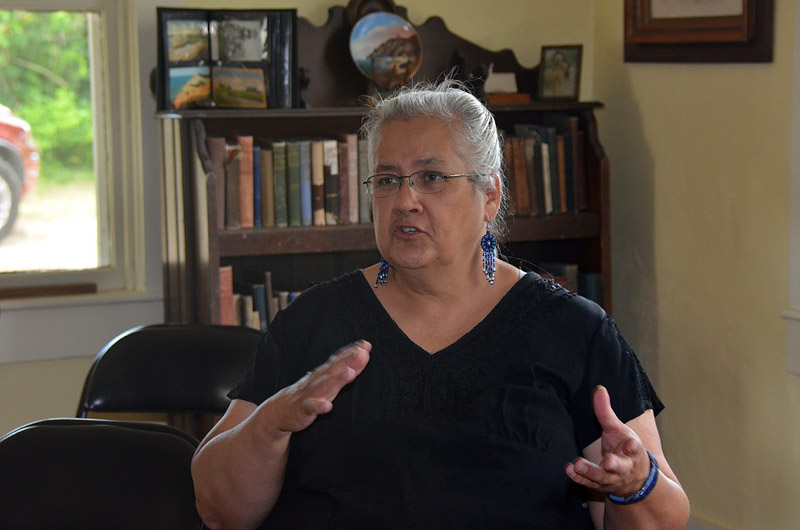When the Europeans arrived on Cape Cod coasts, they hunted whales in large numbers, heading out from ports such as New Bedford, Martha’s Vineyard and Nantucket to harpoon and kill hundreds of the giants each month at the height of the whaling boom. The area grew wealthy on whale oil while the whale population steadily dropped.
Conversely, when Native Americans hunted whales, they worshipped and thanked and used the entire whale. And they only killed about two a month, Yannick Gonsalves explained.
Yannick is 18 and a Wampanoag. Recently he gave a tour of the Aquinnah Cultural Center, also known as the Edwin Vanderhoop Homestead, built by Mr. Vanderhoop in the 1890s. Edwin was half Dutch, half Wampanoag. Pictures of generations of Vanderhoops hang on the walls in the small house. One is of Herbert Vanderhoop, the only man to kill an albino whale, an inspiration for Herman Melville’s Moby Dick.
The Aquinnah Cultural Center is currently hosting the exhibit Captured: 1614 curated by Plymouth 400, which commemorates the 400th anniversary of the arrival of the Mayflower and the settlers’ relationship with the native populations.
Plymouth 400's executive director Michele Pecoraro said, “The Pilgrim story cannot be told without the Wampanoags.”
Captured: 1614 sheds light on a significant time period for the Wampanoag people and the building of this country.
“1614 was the year Squanto was captured,” Aquinnah Cultural Center board member Linda Coombs explained. Squanto was one of 20 men taken from Patuxet, only to return to find his family and village dead. 1614 was also the year that Wampanoag Epanow was returned from Europe after being held captive for four years. Epanow and Squanto were neither the first nor last Native Americans to be victims of human trafficking by Europeans, but Squanto’s experience in particular would forever alter Europe’s relationship with Native Americans.
Plymouth 400 created the exhibit to retell this country’s history in the way it actually happened.
“It’s an unconscious, subconscious move to submerge this history, because it’s not pretty,” Ms. Coombs said. People tend to forget that nations, tribes and settlements thrived on American soil before the Europeans claimed the land. The largest and deadliest introduction for natives was disease. From 1616-1618, a plague infected the native people of Martha’s Vineyard and killed two-thirds of the population.
The first European on Martha’s Vineyard arrived in 1524, Ms. Coombs said, but it wasn’t until the 1640s that Thomas Mayhew “bought” the islands of Martha’s Vineyard, Nantucket and the Elizabeth Islands from King George III. His son, Thomas Jr, went on to colonize the land and Christianize its native peoples. At the time, Martha’s Vineyard was comprised of four main villages: Aquinnah, Takamee (West Tisbury area), Nunapog (Edgartown, primarily its harbor), and Chappaquiddick. The European town of Gay Head was not established until 1870.
“There were roughly 1,000 people per village,” Ms. Coombs said. “There was protocol for going into someone’s area…there were designated areas for fishing and planting…and each village’s Sachem kept track of it all.”
Ms. Coombs said that Native American history is not a side note in American history. It is American history.
“It’s been 400 years and people are so ignorant about this history...about us...it gets old after a while,” Ms. Coombs said. “A country can be judged by the way it treats its indigenous people...that’s not my quote, but I think it’s true,” she added. Captured: 1614 will be at the Aquinnah Cultural Center until mid-September.








Comments (2)
Comments
Comment policy »